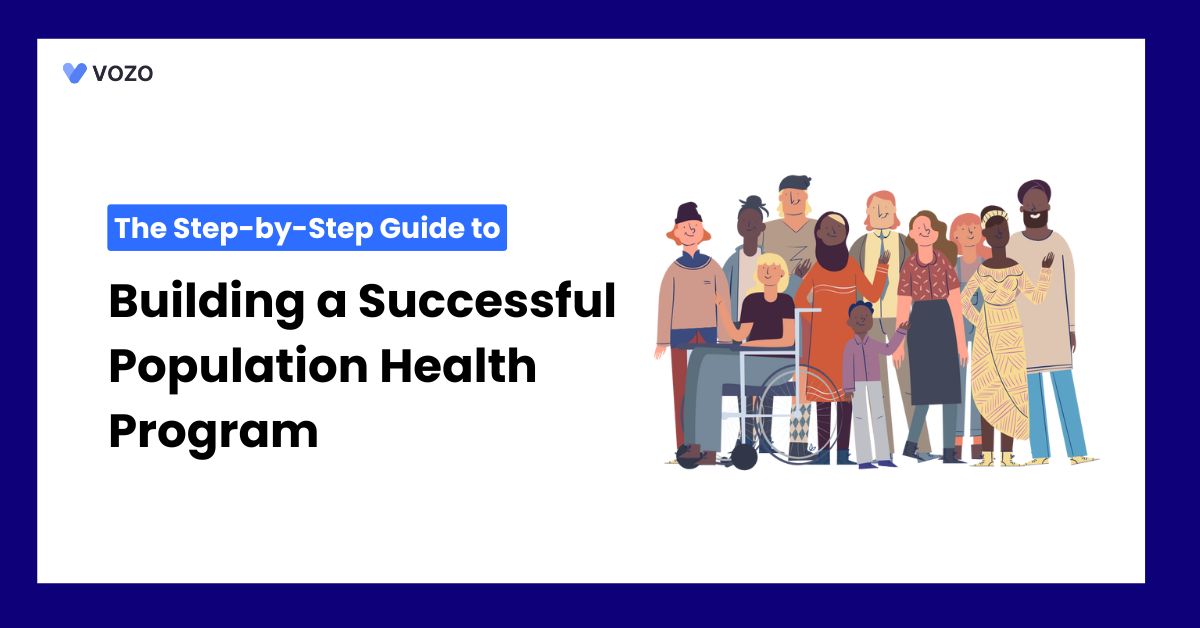The Step-by-Step Guide to Building a Successful Population Health Program
Population health helps communities stay healthier through prevention and early care. It focuses on stopping diseases before they become serious health problems. Unlike regular healthcare, it does not wait until sickness appears. Instead, it works to remove the causes behind health issues.
As healthcare costs rise, many people struggle to afford treatment. That is why population health programs help lower medical expenses significantly. They also make sure healthcare reaches all groups, especially the underserved. With better access, more people get the care they truly need.
In this blog post, we have shared why population health is important, the key benefits of population health programs, and steps to create an effective health program.
Why is Population Health Important?
Population health improves outcomes by addressing various social determinants effectively. It focuses on preventive care, chronic disease management, and health interventions.
Unlike traditional healthcare, it targets root causes rather than symptoms. Rising costs and disease prevalence make it a necessary approach. Health disparities continue to grow, requiring focused community health strategies. These programs reduce burdens by preventing diseases before they escalate.
Related: The Role of EHRs in Value-Based Care and Population Health Management
Key Benefits of a Population Health Program
Implementing population health program benefits in many ways:
1. Improved Health Outcomes
These programs consistently promote early detection and proactive healthcare interventions. Regular screenings, vaccinations, and wellness programs help reduce chronic illnesses.
Identifying health risks early leads to better community well-being overall. Preventive measures lower disease rates and improve public health sustainability.
2. Cost Reduction
Preventive care significantly reduces emergency visits and hospital admissions efficiently. Costly medical interventions decrease, saving money for both providers and patients.
Lower healthcare expenditures benefit insurance companies, governments, and healthcare institutions alike. Early detection ensures fewer complications, lowering treatment expenses for everyone involved.
3. Health Equity and Reduced Disparities
Healthcare access disparities exist in many underserved communities today. Population health programs address economic, geographic, and social barriers to care.
Vulnerable populations receive the necessary medical attention to improve their health. Equal access fosters healthier societies by addressing systemic healthcare inequalities directly.
4. Enhanced Patient Engagement and Education
Health education empowers individuals to manage their health better. Digital health tools and awareness campaigns enhance knowledge among different populations.
When people understand healthcare options, they make informed decisions independently. Empowered individuals take proactive steps toward effectively maintaining healthier lifestyles.
Related: Key Benefits of Predictive Analytics in Population Health Management
Steps to Build a Successful Population Health Program
Step 1 – Conduct a Community Health Assessment
It is important to assess the community’s health before implementing a population health program. A health assessment involves:
- Collecting and analyzing data like census reports, and national health databases from EHRs.
- Conducting surveys and focus groups to gather community feedback on healthcare accessibility and prevalent health issues.
- Identifying social determinants of health that impact well-being.
- Mapping out high-risk populations and geographic areas that require targeted interventions.
A well-conducted assessment provides a data-driven foundation for designing a program tailored to the specific needs of the community.
Step 2 – Build a Collaborative Leadership Team
A multidisciplinary leadership team is essential to oversee and implement a population health program effectively. This team should include:
- Healthcare providers (physicians, nurses, public health officials)
- Community leaders and advocacy groups
- Government agencies and policymakers
- Insurance providers and employers
- Nonprofit organizations and social service agencies
Collaboration ensures resource allocation aligns with community health priorities successfully.
Establishing a shared vision and open communication channels among stakeholders promotes program alignment and long-term sustainability.
Step 3 – Set Clear and Measurable Goals
Goals must be specific, measurable, achievable, relevant, and time-bound. Reducing diabetes cases by implementing nutrition programs is one example.
- Increasing vaccination rates through awareness campaigns improves public health outcomes significantly.
- Clear objectives help measure program success and adjust strategies accordingly.
- Establishing benchmarks keeps initiatives aligned with intended health outcomes effectively.
Step 4 – Design and Implement Evidence-Based Interventions
Effective population health programs use evidence-based strategies to address key health concerns. Some proven interventions include:
- Encouraging regular health screenings for diseases such as cancer, hypertension, and diabetes.
- Implementing structured programs for conditions like asthma, obesity, and heart disease.
- Conducting workshops on nutrition, exercise, and mental health to promote healthy lifestyles.
- Using digital tools to improve access to care for rural or underserved populations.
Tailoring interventions to cultural and socioeconomic factors enhances participation meaningfully.
Step 5 – Utilize Health Information Technology
Technology improves data collection, analysis, and communication among healthcare stakeholders efficiently. Electronic health records integrate patient histories for better care coordination seamlessly.
Predictive analytics help identify high-risk populations needing immediate intervention programs. Wearable devices track health metrics, promoting patient engagement and awareness effectively. Digital platforms enhance accessibility to medical consultations and health education consistently.
Step 6 – Engage and Empower the Community
Community involvement strengthens the success of population health programs significantly.
- Public awareness campaigns educate residents on effective preventive healthcare measures.
- Local partnerships expand outreach efforts and foster collaborative healthcare solutions.
- Incentives encourage community participation in wellness initiatives and screenings regularly.
- Patients who feel engaged take proactive steps towards healthier living decisions.
Step 7 – Monitor, Evaluate, and Improve the Program
Continuous evaluation ensures population health programs remain effective over time. Data-driven decisions refine existing interventions and optimize resource utilization efficiently. Tracking performance metrics like hospital admissions helps measure program impact accurately.
Regular feedback from healthcare providers ensures adjustments align with evolving needs. Effective evaluation continuously enhances long-term sustainability and community health improvements.
Vozo Cloud EHR for Population Health Management
If you are searching for the best EHR system for your healthcare practice, Vozo EHR can be your go-to choice. Our comprehensive EHR solution lets you focus more on patient care while carrying all the burdens and simplifying it.
- Vozo Cloud EHR’s cost-effective cloud subscription benefits all levels of practice.
- Our feature-rich EHR helps you rectify mistakes efficiently and speed up the process.
- Vozo Specialty EHR resonates with specialty practice needs and requirements.
- Our expert technical team got you covered 24/7 if any needs arise.
- Our EHR System continues to scale as your healthcare practice grows to improve the user experience.
The Vozo Customized EHR solution benefits your healthcare practice by:
- Streamlining the administrative process
- Improving workflow efficiency
- Reducing proneness to errors
- Manages all the patient’s records in one place
- Offers greater efficiency and cost-savings across the board.
Our specialty-specific tools, such as scheduling, patient portals, lab integration, cloud hosting, and more, meet your healthcare practice’s specific needs and requirements.
“Embrace Vozo EHR to Reduce Your Burdens and Enhance Patient Care”.
About the author

With more than 4 years of experience in the dynamic healthcare technology landscape, Sid specializes in crafting compelling content on topics including EHR/EMR, patient portals, healthcare automation, remote patient monitoring, and health information exchange. His expertise lies in translating cutting-edge innovations and intricate topics into engaging narratives that resonate with diverse audiences.













